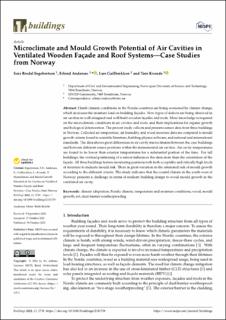| dc.contributor.author | Ingebretsen, Sara Bredal | |
| dc.contributor.author | Andenæs, Erlend | |
| dc.contributor.author | Gullbrekken, Lars | |
| dc.contributor.author | Kvande, Tore | |
| dc.date.accessioned | 2022-10-28T05:53:07Z | |
| dc.date.available | 2022-10-28T05:53:07Z | |
| dc.date.created | 2022-10-27T07:40:02Z | |
| dc.date.issued | 2022 | |
| dc.identifier.citation | Buildings. 2022, 12 (10), . | en_US |
| dc.identifier.issn | 2075-5309 | |
| dc.identifier.uri | https://hdl.handle.net/11250/3028731 | |
| dc.description.abstract | Harsh climatic conditions in the Nordic countries are being worsened by climate change, which increases the moisture load on building façades. New types of defects are being observed in air cavities in well-designed and well-built wooden façades and roofs. More knowledge is required on the microclimatic conditions in air cavities and roofs, and their implications for organic growth and biological deterioration. The present study collects and presents sensor data from three buildings in Norway. Collected air temperature, air humidity, and wood moisture data are compared to mould growth criteria found in scientific literature, building physics software, and national and international standards. The data shows great differences in air cavity microclimates between the case buildings and between different sensor positions within the instrumented air cavities. Air cavity temperatures are found to be lower than exterior temperatures for a substantial portion of the time. For tall buildings, the vertical positioning of a sensor influences the data more than the orientation of the façade. All three buildings feature monitoring positions with both acceptable and critically high levels of moisture to indicate mould risk. There is great variation in the estimated risk of mould growth according to the different criteria. The study indicates that the coastal climate in the south-west of Norway presents a challenge in terms of resilient building design to avoid mould growth in the ventilated air cavity. | en_US |
| dc.language.iso | eng | en_US |
| dc.rights | CC BY 4.0 | * |
| dc.rights.uri | http://creativecommons.org/licenses/by/4.0/ | * |
| dc.subject | Climate adaptation | en_US |
| dc.subject | Nordic climate | en_US |
| dc.subject | Temperature and moisture conditions | en_US |
| dc.subject | Wood | en_US |
| dc.subject | Mould growth | en_US |
| dc.subject | Rot | en_US |
| dc.subject | Dual-barrier weatherproofing | en_US |
| dc.title | Microclimate and Mould Growth Potential of Air Cavities in Ventilated Wooden Façade and Roof Systems—Case Studies from Norway | en_US |
| dc.title.alternative | Microclimate and Mould Growth Potential of Air Cavities in Ventilated Wooden Façade and Roof Systems—Case Studies from Norway | en_US |
| dc.type | Peer reviewed | en_US |
| dc.type | Journal article | en_US |
| dc.description.version | publishedVersion | en_US |
| dc.rights.holder | © 2022 The authors | en_US |
| dc.subject.nsi | VDP::Teknologi: 500 | en_US |
| dc.source.pagenumber | 23 | en_US |
| dc.source.volume | 12 | en_US |
| dc.source.journal | Buildings | en_US |
| dc.source.issue | 10 | en_US |
| dc.identifier.doi | 10.3390/buildings12101739 | |
| dc.identifier.cristin | 2065454 | |
| dc.relation.project | Norges forskningsråd: 237859 | en_US |
| dc.relation.project | Norges forskningsråd: 309400 | en_US |
| dc.source.articlenumber | 1739 | en_US |
| cristin.ispublished | true | |
| cristin.fulltext | original | |
| cristin.qualitycode | 1 | |

